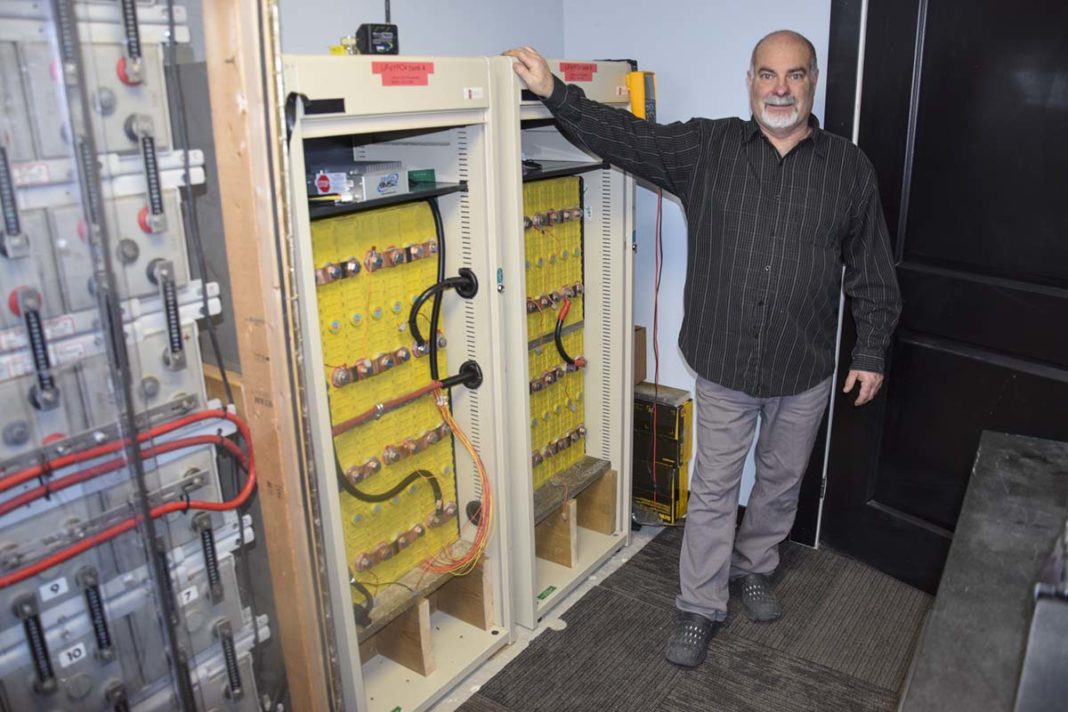LITTLE CURRENT—Craig Timmermans has always been fascinated by technology and scientific advancements and that has led him to establish a series of “firsts” on Manitoulin. His company established the first internet service provider on Manitoulin and went on to build a community radio station that eventually blossomed into a full-blown commercial country radio station.
Radio stations consume an enormous amount of energy, however, and that led Mr. Timmermans to take the radio station he operates with his wife Kelly (KT) off-grid. It was that decision that indirectly led to his latest innovation—a green charging station for electric vehicles.
“The advances in solar energy and storage capacity over the past few years has been enormous,” said Mr. Timmermans. “In taking Country 103 off the grid, I discovered that I had quite a lot of excess energy that was, really, just going to go to waste otherwise.”
That’s when the concept of creating the Island’s first totally green charging station popped into his fertile imagination. By harnessing the excess energy captured from the sun by his bank of highly efficient solar panels, he realized he could power an electric vehicle charging station far more economically than he could by connecting one to the province’s energy grid.
The new lithium power cells that store the energy coming from the solar panels play a pivotal role in making both the radio station and the new charging station not only economically viable but a sensible route for the radio station to follow.
“They are not only double the capacity of the old batteries, but they are also half the cost,” said Mr. Timmermans.
A battery monitor maintains the balance between each of the bright yellow power cells, ensuring that each cell is charged at the proper rate. “Lithiums have to have these kind of regulator,” he said. “If you didn’t have the monitor, the cells could overcharge, wrecking them.”
The old battery system will remain in place as a backup, but the new cells will be doing the main work.
The monitor and auto-generator starter communicate through Wi-Fi allowing Mr. Timmermans to stay on top of the system anywhere through the internet.
Another bonus of advancing technology is that the system controls take up a fraction of the space of the old systems. “This whole wall was covered in a bank of control panels,” said Mr. Timmermans. “Now it’s just this one small panel and everything is connected.”
“Now that we have so much available energy, we will be putting an electric vehicle charging station just outside of the window here,” he said, indicating a window looking out towards the Manitoulin Country Fest grounds. “We will have it set up 24 hours a day. People will be able to pay by credit card or whatever. We will be cheaper than what the other guys can sell it for.”
The plan is to have a single charging bay to start to see how things go, with managed growth based on demand. The charging station will be able to service both Tesla and standard vehicles. “It will be a class two charging station,” said Mr. Timmermans. He explains that a class one station is a home system that hooks up to a standard outlet and will charge a vehicle in about 12 hours. “A class two does the same job in an hour to three hours,” he said. “They can wander about here, or maybe head up to a grocery store (if one happens to be built up the road from here).”
The other option available would be a class three, or supercharger system.
“A supercharger, class three, it will do it in 15 to 20 minutes,” he said. “I could do it, but I would have to install a whole bunch more solar panels and batteries. That kind of defeats the whole purpose of using the surplus energy.” The other challenge, he notes, is that the supercharger is very hard on batteries, wearing them out at a very high rate.
Mr. Timmermans purchased his equipment from Canadian Solar. “They come with a 25-year warranty and are 445 watts for each panel,” he said. “The old ones were 230 watts, so double almost and they cost only $230 a panel. You look at the 200 watt panels you get at a hardware store, they are $200, yet for a few dollars more you get a commercial grade panel with a 25-year warranty. It was really a no-brainer.”
Mr. Timmermans was so impressed with the product that he has taken on a distributorship and is retailing the panels himself. “I have already installed the systems at businesses in Sudbury and Espanola,” he explained.
“One guy asked me why I don’t hook it up to the grid, but I am never doing that again,” said Mr. Timmermans. “What Hydro does then is charge you for a delivery rate and you wind up making almost nothing. It’s crazy, you make nothing—it’s ‘thanks for the free energy.’ I will make more from setting up the charging station.”
He speaks from experience, as in years past, Mr. Timmermans constructed his own alternative fuel generator that was hooked up to the grid and discovered the costs imposed by the provincial operator proved too onerous to continue.
“I was talking to a cabinet minister I met at a luncheon,” recalled Mr. Timmermans. “He said they don’t want people doing what I am because it would take away from the provincial system. Well, I think maybe that’s a good thing. Maybe it’s time for a reset at Hydro One. I don’t think there is a lot of care being taken with taxpayers dollars.”
In the meantime, Hydro One’s loss is Manitoulin’s gain. The Island produces at least as much energy as it uses through the wind farm operations and the hydro generating plant located at Bridal Veil Falls in Kagawong, and soon Manitoulin will boast a electric vehicle charging station powered by solar energy.
“It’s the way of the future,” said Mr. Timmermans, and following a lifetime of being on the cusp of new developments, he is one to know.




